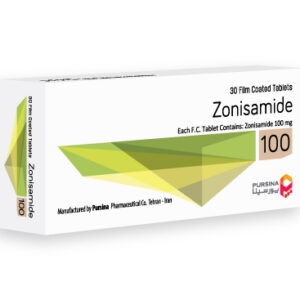Description
How Supplied:
Carbamazepine tablets are presented as forms containing 200mg Carbamazepine, 10 tablets per blister pack, 10 blisters with a leaflet in a box.
Category:
Anticonvulsant, antineuralgic (specific pain syndromes), antimanic, antipsychotic
Pregnancy and Breastfeeding:
It is not recommended to use this medicine during pregnancy and breastfeeding.
Precautions:
-Checking with physician before discontinuing medication, gradual dosage reduction may be needed.
– Not drinking grapefruit juice or eating grapefruit.
– Not using medication for minor aches and pains.
-Avoiding the use of alcoholic beverages and other CNS depressants while taking this medicine.
-Contacting physician immediately if fever, sore throat, rash, ulcers in the mouth, easy bruising, petechial or purpuric hemorrhage occur, these could be signs of a potential hematologic problem.
-Possible skin photosensitivity, avoiding unprotected exposure to sun, using protective clothing, using a sun block product that includes protection against both UVA-caused photosensitivity reactions and UVB-caused sunburn reactions, avoiding use of sunlamp, tanning bed, or tanning booth.
-Using different or additional means of birth control than estrogen containing oral contraceptives.
-Caution if any laboratory tests required, possible interference with results of metyrapone or pregnancy tests.
-Caution if any kind of surgery, dental treatment, or emergency treatment is needed.
-Diabetic patients: May increase urine sugar concentrations.
-Possible drowsiness, dizziness, lightheadedness, blurred or double vision, weakness or muscular incoordination, caution when driving or using machinery, or doing jobs requiring alertness and coordination.
Drug Interactions
Inform your doctor if you are taking any of the following medicines:
Acetaminophen, Aminophylline, Oxtriphylline, Theophylline, Anticoagulants (coumarin or indandione derivative), Anticonvulsants (hydantion, succinimide), Barbiturates, Benzodiazepines metabolized via hepatic microsomal enzymes especially Clonazepam, Primidone, Valproic acid, Tricyclic Antidepressants, Clozapine, Haloperidol, Loxapine, Maprotiline, Molindone, Phenothiazines, Pimozide, Thioxanthenes, Anti-malarial drugs (Chloroquine or Mefloquine), Carbonic anhydrase inhibitors, Chlorpropamide, Desmopressin, Lypressin, Thiazide diuretics, Vasopressin, Cimetidine, Cisplatin, Doxorubicin, Rifampin, Clarithromycin, Clomipramine, CNS acting drugs, Alcohol, Estrogens- containing Contraceptives, oral Cyclosporine, Dacarbazine, Digitalis glycosides, with the possible exception of digoxin, Disopyramide, Estrogens (including Estramustine), Methadone, Mexiletine, Quinidine, Corticosteroids, CYP 1A2 substrates (including: Mirtazapine, Olanzapine, Quetiapine, Tramadol, Triazolam, Warfarin, Zonisamide) CYP 3A4 inhibitors (including: Dalfopristin, Grapefruit juice, Nefazodone, Nicotinamide) Protease inhibitors, Quinine, Quinupristin, Valproate, Zileuton, Delavirdine, Danazol, Diltiazem, Felodipine, Loratadine, Niacinamide, Terfenadine, Verapamil, Doxycycline, Enflurane, Halothane, Methoxyflurane, Erythromycin, Troleandomycin, Felbamate, Folic Acid, Fluoxetine, Fluvoxamine, Influenza virus vaccine, Isoniazid, Isotretinoin, Itraconazole, Ketoconazole, Lamotrigine, Lithium, Mebendazole, Metoclopramide, Monoamine Oxidase (MAO) inhibitors including Pancuronium, Praziquantel, Propoxyphene, Risperidone, Tiagabine, Topiramate.
Dosage and Administration
Usual adult and adolescent dose:
- Anticonvulsant
Initial: oral, 200 mg two times a day, the dosage being increased by up to 200 mg a day at weekly intervals until the best response is obtained.
Maintenance: Oral, usually 600 mg to 1.2 gr a day
Patients 12 to 15 years of age: Dosage should generally not exceed 1 gram a day.
Patients 15 years of age and over: Dosage should generally not exceed 1.2 grams a day.
- Antineuralgic
Initial: Oral, 100 mg two times a day, the dosage being increased by up to 200 mg a day, using increments of 100 mg every twelve hours only as needed.
Maintenance: Oral, 200 mg to 1.2 gr a day (average 400 to 800 mg a day) in divided doses.
Dosage should not exceed 1.2 gr a day.
- Antimanic or Antipsychotic
Oral, initially 200 to 400 mg a day in divided doses, the dosage being gradually increased at weekly intervals up to a maximum of 1.6 gr a day as needed and tolerated according to clinical response.
Note: Whenever possible, total daily dosage should be given in 3 or 4 divided doses.
Usual pediatric dose:
Anticonvulsant
– Children up to 6 years of age:
Initial: Oral, 10 to 20 mg per kg of body weight a day in two or three divided doses, the dosage being increased by up to 100 mg a day at weekly intervals as needed and tolerated
Maintenance: Oral, usually 250 to 350 mg a day and generally not exceeding 400 mg or 35 mg per kg of body weight a day.
– Children 6 to 12 years of age:
Initial: Oral, 100 mg two times a day, the dosage being increased by 100 mg a day at weekly intervals until the best response is obtained.
Maintenance: Oral, usually 400 to 800 mg a day
Note: Dosage generally should not exceed 1 gr a day.
Whenever possible, total daily dosage should be given in 3 or 4 divided doses.
Side Effects:
Those indicating need for medical attention
CNS toxicity, allergic reaction, toxic epidermal necrosis, anxiety, ataxia, behavioral changes, chest pain, depersonalization, depression, diarrhea, severe extrapyramidal symptoms, hyponatremia, delusional manic reaction, suicide ideation or attempt, systemic lupus erythematosus (SLE)-like syndrome, infection, manic depressive reaction.
Those indicating need for medical attention only if they continue or are bothersome
Clumsiness or unsteadiness, confusion, dizziness, mild, or light headedness, drowsiness, nausea or vomiting.
Storage
Store below 30˚C. Protect from light and moisture.
Keep out of reach of children.
Manufactured by Pursina Pharmaceutical Co Tehran-Iran


